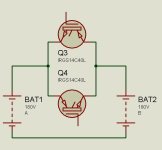peterperkins
100 W
- Joined
- Jun 6, 2008
- Messages
- 196
Lets assume we have two 180V ish battery packs A & B that we want to connect in parallel but in a controlled fashion.
They won't always be at the same voltage and I want to control; the power flow back and forth between them as they fluctuate.
A will sometimes be higher than B by say upto 50V and vice versa.
I want about 10-20A bi-directional current flow pwm controlled max between them independently controlled.
I was thinking two discrete IGBT'S paralleled in reverse inserted into the + line ..
Each controlled by an isolated pwm driver.
The potential difference between the packs would help control the current flow.
The independent pwm for each direction could be set as the ultimate current limit at the maximum pack voltage disparity.
So one IGBT controls flow when A is higher V than B and the other when B is higher V than A...
Make sense? Any nightmare issues?

They won't always be at the same voltage and I want to control; the power flow back and forth between them as they fluctuate.
A will sometimes be higher than B by say upto 50V and vice versa.
I want about 10-20A bi-directional current flow pwm controlled max between them independently controlled.
I was thinking two discrete IGBT'S paralleled in reverse inserted into the + line ..
Each controlled by an isolated pwm driver.
The potential difference between the packs would help control the current flow.
The independent pwm for each direction could be set as the ultimate current limit at the maximum pack voltage disparity.
So one IGBT controls flow when A is higher V than B and the other when B is higher V than A...
Make sense? Any nightmare issues?


